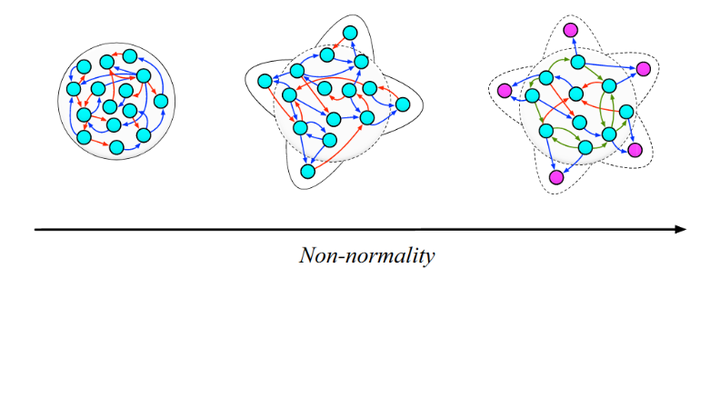Hierarchical route to the emergence of leader nodes in real-world networks
 The emergence of leaders with increasing non-normality; schematic illustration of the evolution of hierarchical structure within networks ranging from random graphs (left panel) before a hierarchical structure develops with increasingly non-normal structure (middle panel). When non-normality surpasses an empirical threshold, leader (sink) nodes – in magenta – emerge at the top hierarchical level across the ensembles of networks. Edge colors represent the direction within the hierarchical structure; blue for those going up, red for those which point downwards and green for nodes at the same hierarchical level.
The emergence of leaders with increasing non-normality; schematic illustration of the evolution of hierarchical structure within networks ranging from random graphs (left panel) before a hierarchical structure develops with increasingly non-normal structure (middle panel). When non-normality surpasses an empirical threshold, leader (sink) nodes – in magenta – emerge at the top hierarchical level across the ensembles of networks. Edge colors represent the direction within the hierarchical structure; blue for those going up, red for those which point downwards and green for nodes at the same hierarchical level.Abstract
A large number of complex systems, naturally emerging in various domains, are well described by directed networks, resulting in numerous interesting features that are absent from their undirected counterparts. Among these properties is a strong non-normality, inherited by a strong asymmetry that characterizes such systems and guides their underlying hierarchy. In this work, we consider an extensive collection of empirical networks and analyze their structural properties using information-theoretic tools. A ubiquitous feature is observed amongst such systems as the level of non-normality increases. When the non-normality reaches a given threshold, highly directed substructures aiming towards terminal (sink or source) nodes, denoted here as leaders, spontaneously emerge. Furthermore, the relative number of leader nodes describe the level of anarchy that characterizes the networked systems. Based on the structural analysis, we develop a null model to capture features such as the aforementioned transition in the networks' ensemble. We also demonstrate that the role of leader nodes at the pinnacle of the hierarchy is crucial in driving dynamical processes in these systems. This work paves the way for a deeper understanding of the architecture of empirical complex systems and the processes taking place on them.
Find more information at https://doi.org/10.1103/PhysRevResearch.3.023117